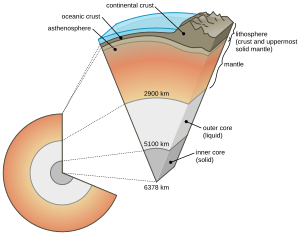Earth's core facts for kids
The Earth's core is the super hot center of our planet. It's made of two main parts: a solid inner core and a liquid outer core. Think of it like a giant peach, with the core being the pit! The temperature in the outer core can be as hot as 4,400°C in its outer parts, reaching up to 6,100°C closer to the inner core. That's hotter than the surface of the Sun!
The Liquid Outer Core
The outer core is a thick layer of liquid metal, about 2,260 kilometers deep. It's mostly made of iron and nickel. This liquid layer sits above the solid inner core and below the mantle, which is another layer of our planet. The top of the outer core is about 2,890 kilometers beneath Earth's surface.
The super hot liquid metals in the outer core are constantly moving. This movement creates eddy currents, which are like swirling patterns in the fluid. These currents, along with something called the Coriolis effect (which is caused by Earth's spin), are what create our planet's powerful magnetic field. The solid inner core is too hot to have its own permanent magnetic field, but it helps to keep the magnetic field from the outer core stable.
The magnetic field inside the outer core is incredibly strong. It's about 50 times stronger than the magnetic field we feel on the Earth's surface!
Without the outer core and its magnetic field, life on Earth would be very different. This magnetic field stretches thousands of kilometers into space, forming a protective bubble around Earth called the magnetosphere. This bubble acts like a shield, deflecting harmful particles from the Sun called solar wind. If we didn't have this shield, the solar wind would hit Earth's atmosphere directly. Over time, this could strip away our atmosphere, making our planet almost impossible to live on. Scientists believe this might have happened to Mars, which now has a very thin atmosphere.
The Solid Inner Core
The inner core of the Earth is a solid sphere right at the very center. Scientists study it using seismology, which involves looking at how earthquake waves travel through the Earth. This solid ball is about 1,216 kilometers wide, which is about 70% the size of our Moon.
Scientists believe the inner core is mostly an iron–nickel alloy. Its temperature is thought to be similar to the surface of the Sun, around 5,505°C.
In 2015, some researchers suggested that the inner core might actually have two layers! They looked at how seismic waves traveled through it. Their data showed that tiny crystals in the "inner inner core" seemed to be lined up in an east-to-west direction. But the crystals in the "outer inner core" (the part surrounding the very center) were lined up north to south. This is a big discovery if true, as it would mean something major happened in Earth's past to change the way these crystals are aligned. Other scientists are now carefully checking this new information.
Images for kids
-
World map showing the position of the Moho, a boundary inside Earth.



